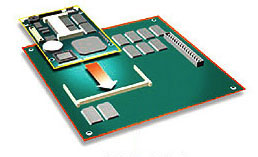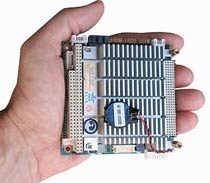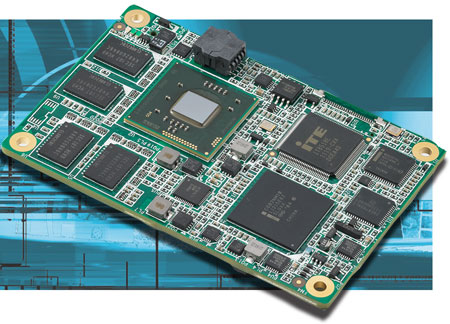When most people think of computers they think of desktops, notebooks and servers. What's less well known is that untold millions of computers are embedded in all sorts of machinery and equipment ranging from games to digital signage, automotive applications, ATMs, and a wide variety of industrial and control systems. These computers bear little resemblance to laptops or other consumer and commercial computers; they are generally just small circuit boards, albeit boards that are designed to provide targeted functionality in a variety of industry standard form factors.
Embedded systems design is very different from designing consumer or even vertical market computing products. The life cycles of these systems is much longer than the rapid-fire change in consumer products, often five to seven years.  Once a design problem has been solved, there is no need to reinvent the wheel, but there is a need to keep up with new processor, interface and peripheral technologies. As a result, embedded systems often include two components. They consist of what's called a "solution" or "carrier" board that then accommodates a small System-On-Module (SOM) board that includes the CPU, chipset, memory and other core functionality. This approach frees designers and system integrators from having to design a whole new computer every time they switch processors. This way, they can design their solution, and then just pop in a new SOM. This means no more CPU integration concerns, always being able to offer the latest technologies, and getting to market very quickly. In fact, if you open some of the rugged machines we're reviewing here at RuggedPCReview.com, you'd find that many use this approach: they have a solution board and then a system-on-module based on speed and feature requirements.
Once a design problem has been solved, there is no need to reinvent the wheel, but there is a need to keep up with new processor, interface and peripheral technologies. As a result, embedded systems often include two components. They consist of what's called a "solution" or "carrier" board that then accommodates a small System-On-Module (SOM) board that includes the CPU, chipset, memory and other core functionality. This approach frees designers and system integrators from having to design a whole new computer every time they switch processors. This way, they can design their solution, and then just pop in a new SOM. This means no more CPU integration concerns, always being able to offer the latest technologies, and getting to market very quickly. In fact, if you open some of the rugged machines we're reviewing here at RuggedPCReview.com, you'd find that many use this approach: they have a solution board and then a system-on-module based on speed and feature requirements.
 What is the division of labor between the carrier board and the system-on-module? In general, the SOM handles the CPU as well as most of the basic circuitry. Often, the SOM covers 80% or so of all feature requirements. There are no hard rules, and designers often divide functionality according to project requirements. Simplicity is often key, as are reliability, fanless operation, cost, and power consumption. High performance may be required in some embedded systems, but a large number only need "targeted" performance, i.e. just enough to do the job at hand.
What is the division of labor between the carrier board and the system-on-module? In general, the SOM handles the CPU as well as most of the basic circuitry. Often, the SOM covers 80% or so of all feature requirements. There are no hard rules, and designers often divide functionality according to project requirements. Simplicity is often key, as are reliability, fanless operation, cost, and power consumption. High performance may be required in some embedded systems, but a large number only need "targeted" performance, i.e. just enough to do the job at hand.
Bus and interface standards change over time. A bus standard will scale to a certain level but eventually max out and be replaced by faster standards with new technologies and additional signals. Advantech supports all major standards because unique peripherals and technologies may rely on various bus and interface types. For example, USB did not totally replace serial connections and today the RS232/422/485 standard is still used in many industrial and vertical applications. Likewise, while parallel interfaces have largely been replaced by low-voltage differential signaling (LVDS), legacy parallel may still require support.
SOM-144 -- Introduced in 2001 by Advantech to speed embedded systems development, SOM-144 uses the 144-pin SODIMM connector from which it got its name for IDE, PCI and USB, whereas special signals go through an 80-pin front-end connector. SOM-144 boards are very small, measuring just 3.94 x 2.68 inches, and remain a viable choice for many projects due to their simplicity and reliability.

ETX -- The ETX Industrial Group created ETX (Embedded Technology eXtended) to support new technologies and guard against obsolescence. The small 4.5 x 3.75 inch ETX modules use the PCIe bus but still offer full ISA, RS-232, parallel and PS/2 legacy support. They use a standardized connector layout with four 99-pin connectors--X1 to X4--that attach the ETX module to the carrier board.
XTX -- XTX was introduced in 2005 as an expansion of the proven ETX standard with the goal of adding the latest I/O technologies. XTX boards are the same size as ETX boards and use the same four 99-
pin connectors, but instead of ISA bus signals, the X2 connector carries the LPC bus, serial ATA, PCIexpress, ExpressCard, a digital audio CODEC and additional USB lines.
COM-Express -- COM-Express, introduced in 2005 by the PCI Industrial Computer Manufacturers Group (PICMG) of which Advantech is an executive member, is based on serial differential signaling technology for high performance embedded computing that requires maximum I/O bandwidth, such as medical imaging, industrial automation, mapping, security, aerospace, etc.
RISC-based COMs -- For use with Windows Embedded Compact applications embedded system vensors also offers a variety of RISC/XScale-based COMs. -- Conrad H. Blickenstorfer, Ph.D.



